Facing a long recovery from serious injury in the final months of 2019, Brett Parbery realised he could lie on the couch watching Netflix and take pity on himself or use the time to map out the next stage of his career. He chose the latter, and he hasn’t looked back.
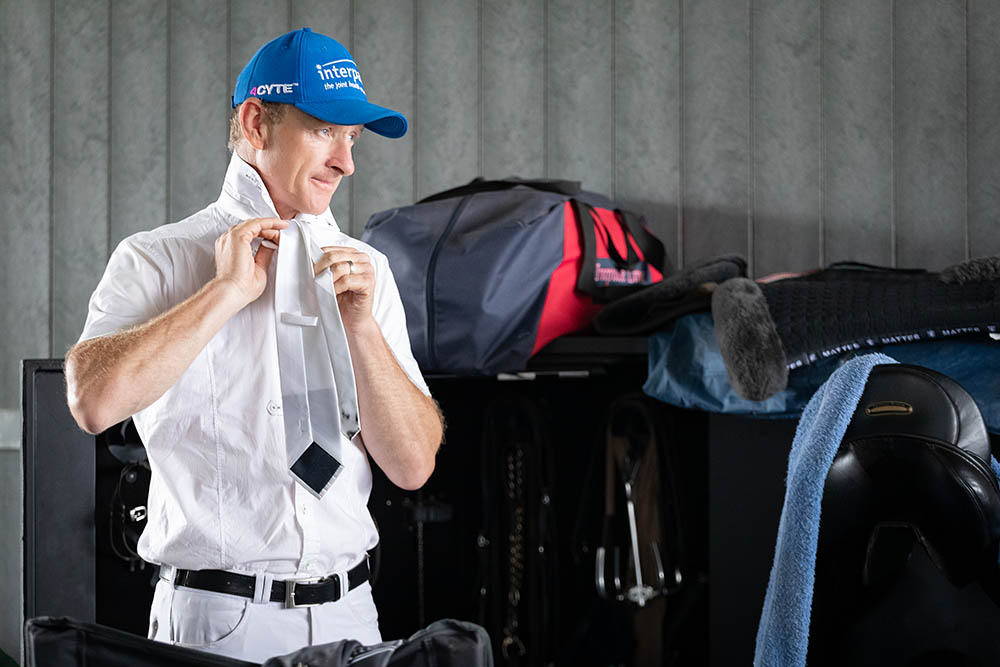
That was one of the best
phone calls I’ve had.
“A really good childhood friend of mine called and said to me, ‘This is what you’re going to do. You’re going to write down five things that you’re going to achieve in the next three months. Get in and tie up all the loose ends, and get in and make decisions that set you up for when you’re back riding again’.
“That was one of the best phone calls I’ve had,” Brett reminisces. “That advice, coaching and friendship set me up to make sure that time on the lounge was well spent!”
The year 2019 had been a big one. As the head dressage rider for Willinga Park, Brett had a large team of quality horses in work and a busy training and competition schedule. However, a freak accident involving a fall from a young horse not only resulted in a broken femur and hip; it also served as the catalyst for unforeseen change.
“My friend’s advice helped me make some big decisions. The first and most important decision was to leave Willinga Park and come back home. I made the difficult decision to let Willinga Park know that I wasn’t going to be renewing my contract,” Brett explains. And so, he began planning for what his career would look like post-recovery in 2020 and beyond, not realising a curveball would soon be thrown his way.
“The moment I had recovered enough from my injuries to be up and moving, we had to start fighting bushfires in our area for a good six weeks – it really was a six-week distraction. It put a lot of the plans that I had on hold, but that’s okay, that’s part of life.”
Once the fire threat eased, Brett was finally able to truly focus on three main things; firstly, the Parbery Program, an online dressage training system Brett launched in 2019, “That’s something I really believe in and I’m really passionate about,” Brett explains. “It’s yielding results – I’m seeing really great improvements in the students that participate in it, and I wanted to invest more time in it – which is exactly what I’ve done.”
The next focus point for Brett involved reinstating his registration as a property valuer. Prior to becoming a dressage rider and coach, Brett had trained and practised as a valuer, however, he had let that lapse for 10 years due to immersing himself in his successful career in the equine industry.
“I wanted to reinstate that, so I set about doing all of the modules and all of the prior learning, all the updating that had to be done, which was quite tedious actually, but good! I just wanted to get that back into play so I had that career option,” says Brett, adding: “The one thing I didn’t want to do when I started up my own stable again was to go back to having a big stable, running around crazily, with a large team of horses and staff. I just wanted to keep my stable small and boutique. For the amount of riding that I want to do, I want to have the best quality horses I can, and I want to invest more time in them.”
Building a small team of high-quality horses that could be comfortably managed by Brett, his wife Mel, and a maximum of two staff members, was Brett’s third focus point as he looked forward to riding again. “I wanted to focus on getting off the lounge from my injury, and in doing so, they were the three things that I wanted to focus on. When I look back at what we’ve achieved in the last 12 months, it’s really building in a good way. I’m extremely busy, and everything that we’ve got going on is really exciting.
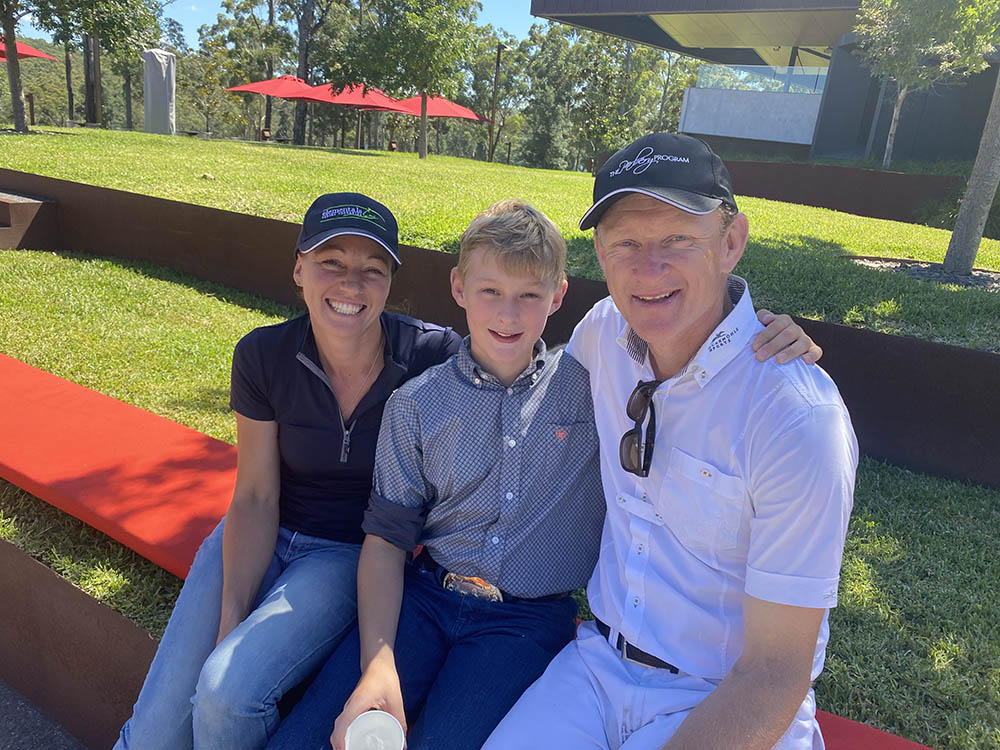
“I feel like I’m probably riding as well,
if not better than I ever have.”
“I currently have some lovely horses in my stable for training” Brett continues. “I’m still looking for possibly one more really top horse that’s owned by really good people who understand the path to Grand Prix. Dressage shouldn’t be about the short-term results, that’s only a distraction.”
“I’m keeping my eyes open for long-term horses that I can take really slowly and get there, as a team, with people who understand the journey. It’s one thing to want to go on the journey and fall in love with the romance of the whole thing… it’s another thing to understand it, and the ups and downs that go with the whole process.”
Fortunately, despite the severity of Brett’s 2019 injury, he is now very comfortable spending time back in the saddle. “I’m still not 100%, I’m still limping and I’ve still got some pain, but it doesn’t hurt when I ride! I feel like I’m probably riding as well, if not better than I ever have. I’ve probably ridden better in Europe over the years, but I feel like I’m now riding with as clear a mind and with as much desire as I’ve ever had.”
Brett’s passion for the sport of dressage is something he is thoroughly enjoying sharing with his students via the Parbery Program. Good horsemanship, intelligent riding and a supportive community are the three pillars forming the foundations of the program, which has seen some exciting developments in the last 12 months.
One positive to come out of the global pandemic has been an accelerated general acceptance and interest in online learning methods. In many ways, this has been a boon for the Parbery Program and validates Brett’s belief in the value of digital platforms for educational purposes.
“Traditionally, a lot of riders out there have not been terribly comfortable with the idea of learning how to do dressage, or horsemanship, online. They have been stuck in the mentality and the mindset that there needs to be some person standing on the ground, telling them from the ground on that day,” Brett muses.
“The other mindset, which completely perplexes me, is the mentality of ‘I’m going to get a little bit of information from this person, then I’m going to get a little bit from that one, then I’ll go and get a lesson from this other one. I’ll get the best of everyone and I’ll have the best superior system!”
“That just does not work. That’s like a football team getting a bit of coaching from every coach in the competition and trying to figure out how to play a game.

What riders need to do is invest in learning a complete system of training from A to Z that, if followed properly, can take them from Preliminary level to Grand Prix. A system that is methodical, logical, simple, and easy to follow and that actually is something you can learn online.”
Brett has been a dressage coach for many years, however, he no longer runs clinics for the general public. Instead, over the past 12 months, he’s established training hubs in Victoria, New South Wales and Queensland at which he runs Super Clinics for Parbery Program students.
With his strong belief in the value of structure and consistency, Brett has continued to develop Dressage Breakthrough. Previously named Dressage Fundamentals, this course is currently the entry point for Parbery Program students. “We rebranded Dressage Fundamentals to Dressage Breakthrough because we found that about 80% of dressage riders felt that they already knew the fundamentals of the sport,” Brett explains. “The wording deterred people, but at the end of the day, the more we do this, the more we realise it’s all about the fundamentals!”
Students progress from Dressage Breakthrough to Gold Performance, a 12-month mentored program that includes structured topics laid out at the beginning of each month, video critiquing online, and priority entry into the Super Clinics at the newly established training hubs. In addition, Brett has added Zoom lessons, something he describes as a game changer.
“Zoom lessons are a little different to the Parbery Program online content and the training hubs. At the training hubs, I go along in person, we all train for the weekend, and we watch video reviews. The online lesson is purely digital, I’m sitting in my office and my student is sitting on their horse, someone’s filming them, and we use Zoom to bring it all together.
“When students have online Zoom lessons, this ties into what they’re learning in the Parbery Program courses, plus we have the training hubs, so it’s a complete system and I am so excited about how much it’s improved their riding!” Brett enthuses.
“I’m working with people that I’ve worked with for years and I’ve noticed a complete demeanour change when they’re riding. They’re more focused, they’re more direct and clearer in their aids. They’re leaving their horses alone more. The muscling in the horses has completely changed. It’s incredible, I’m just blown away, and I never ever thought that that would be the outcome. It’s really satisfying” says Brett. “If anyone was showing negative results I’d be sceptical and I’d be changing things, but I’m seeing really good results. That makes me think we just need to continue getting better at delivering what we’re already doing.”
“In addition to dressage riders, we’re seeing uptake from other disciplines. We’re getting great feedback from show jumpers in the program. As we all know, horses will jump better when they’re travelling better between the fences. The fundamental basics of dressage are absolutely essential to a show jumper,” Brett enthuses. “We’ve also got some high-level eventers, Australian representatives, in the program. They’re giving us great feedback because they’re seeing benefits for both their dressage and their jumping.”
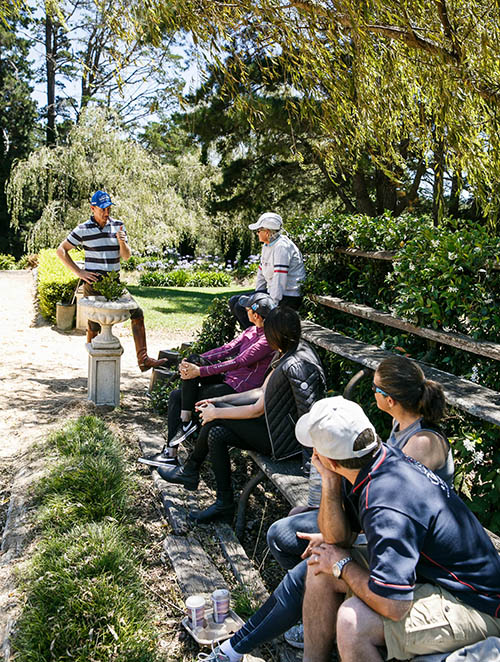
“As we all know, dressage can be
a very, very lonely sport.”
“The thing we’re probably the most
proud of is the community that’s
developing around the program.”
“Overall, the big win for us is watching people enjoying their horses, seeing their horses being trained better. That makes it really worthwhile. But the thing we’re probably the most proud of is the community that’s developing around the program,” Brett explains. “As we all know, dressage can be a very, very lonely sport – not only dressage, any horse sport can be lonely because things can be going wrong, and you’re usually at home by yourself when they do – and you’re not really sure how, or why. We’re finding that the program has created a community where there’s a lot of interaction, you’re never alone. There are so many top riders now involved in the program, so there’s always someone you can bounce something off, someone who’s more experienced than you and happy to help.”
Moving forward, Brett is planning to add a third tier to the Parbery Program’s existing Dressage Breakthrough and Gold Performance courses, named Dressage Essentials. This course will cater for those riders who are in the early stages of their dressage journey.
“A lot of people were giving us feedback that they find it a little bit daunting to come into the program; they feel like they are not at the stage they should be at in order to take part, which is really not the case! On the flip side, some people who have been riding for 10 or 20 years and getting regular coaching, may feel like they’re too advanced to be a part of the program – and that’s also not the case! No matter how good a rider can get, they can always get better at their fundamental training, their consistency and delivery of the aids.”
Brett’s desire to develop dressage riders may be primarily expressed via the Parbery Program these days, however, it still extends beyond that. Since choosing to keep his stable small and boutique, he’s realised that there’s capacity for an up-and-coming rider to share and utilise the impressive facilities he has developed at his base in the New South Wales Southern Highlands.
“We have a really good facility that’s not being fully utilised. I feel that Mel and I have a lot to offer, experience-wise, and that presents an opportunity for the right young rider who wants to start their own business,” Brett explains. “They could lease some of the stables and an apartment at our place. I really want to mentor and help a good, sound, hard-working young professional who wants to add some clients and get some support, some eyes on the ground. Besides, it would be good to have some more youth around the place to keep us on our toes!”
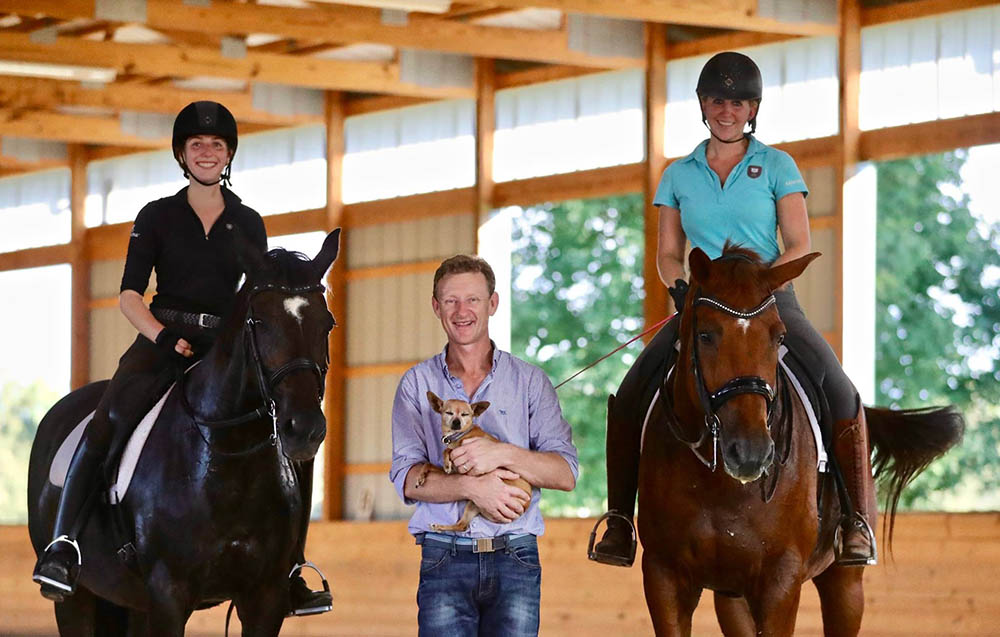
There’s a reason why
some people have good luck
and some people have bad luck.”
Armed with experience and clarity, Brett’s optimistic about the year ahead as he pauses to reflect on what has been achieved in the past 12 months.
“When I look back at what we’ve achieved in the last 12 months, it’s really building in a good way. Sure, the last 12 months have been a bit of a whirlwind – it’s been up and down – but that’s been the case for everyone. I feel so sorry for people who have lost their entire livelihoods due to COVID-19, and incredibly blessed and fortunate that Mel and I have been able to adapt and keep going.”
“From broken bones, to bushfires, to COVID, it was not easy. But looking back on it, we are starting 2021 in a far better position than we started 2020. I have two areas of focus – my boutique stable and the Parbery Program – that I just really love and enjoy.”
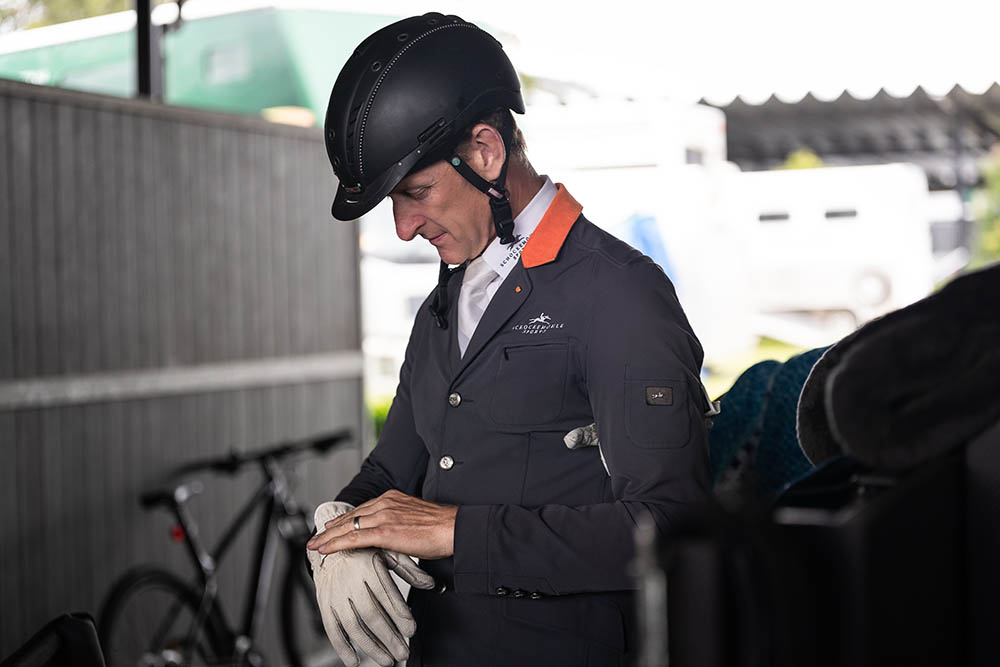
BRETT JOINS THE INTERPATH TEAM
Brett is delighted to have recently joined the Interpath Ambassador team. “We love Interpath, all our dressage horses are on 4Cyte Epiitalis Forte, even the racehorse Mel and I own is on it!” Brett enthuses.
A firm believer in the importance of good management to lay the foundations for a long and successful performance career, Brett believes that a quality joint supplement such as 4Cyte Epiitalis Forte is a critical part of a performance horse’s journey.
“When you’re looking to represent Australia, whether it’s at an Olympics or a World Equestrian Games, first you have to get your horse to Grand Prix. Let’s say he gets there at nine years old to do his first Grand Prix test – that means he’s been in some form of work for five or six years. If you think of all the repetitive work they’ve done – even though the dressage world has come a long way, with good surfaces, great farriers – the impact of repetitive work on joints, ligament and soft tissue is enormous.”
“And that’s just to get to Grand Prix! Once you’re there, it’s another two years to consolidate the work, so by then, the horse might be 11. If the horse and rider are going well and looking to make an Olympic or WEG team, they compete a lot, train a lot, and go through a selection process. They either get selected or they don’t. Then they have another two years and there’s a chance to be on the team again, so they go through the training, competitions and selection again,” Brett explains.
“By this point, there are three years or four years on top of that horse, so it might be 15. Then you want to do another WEG or Olympics with that horse, by now he’s 18!”
“The timing of getting horses to GP early enough is essential. So having the horses on good supplements like 4Cyte is important to help them through the rigorous training to get to Grand Prix. Then you’ve got to ride the Grand Prix with a horse that’s sound, fit and both mentally and physically sound. When you think of the hard miles, I don’t see how anyone could do it without a supplement like 4Cyte Epiitalis Forte.”
“No one wants to be in the heartbreaking position of being ready to go to the Olympic Games only for the horse to have a lameness that they cannot figure out. That makes you reflect on the last 10 to 12 years of training, wondering if there is something you could have done to avoid the situation you’re now in. Of course, there is such a thing as bad luck, but we can’t be as lazy as that, to think that everything is bad luck. There’s always something that we could have changed or done differently,” says Brett.
“There’s a reason why some people have good luck and some people have bad luck. Oftentimes, it’s very small management things, little one-percenters. That’s why we do as much as we can to make sure our horses are sound, fit and healthy. Good nutrition, good farrier, good surfaces – making sure every little bump is picked up on, and that they get their daily 4Cyte— it all adds up in the end.” EQ

